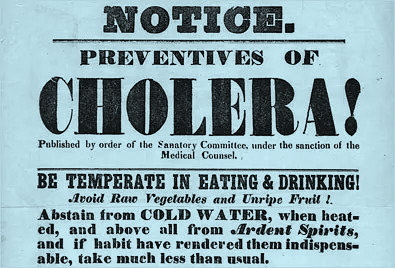Cholera and COVID-19: Change and Continuity in the Landscape of Public Illness
Take for instance the present epidemic, and though no language can describe the suffering, the agony, and the innumerable evils that it brings upon mankind; yet will it pass away without inculcating any important truth? will it teach no profitable lesson to the present and succeeding generations?
(Brigham, A Treatise on Epidemic Cholera, 1832)
The second cholera pandemic, which began in 1829 and would not completely subside until 1851, originated in India and spread to countries in both Europe and the Americas through European trade and shipping routes. It was one of the seven cholera epidemics that afflicted people from around the world.
In analyzing the social effects of the cholera outbreak, we discovered that it produced two striking, but opposing outcomes: unity and division.
First, amidst the uncertainty and confusion of the cholera pandemic, churches characterized the pandemic as chastisement from providence, a message that unified religious communities and produced social cohesion. The spread of cholera coincided with the Second Great Awakening, a height of religious fervor that began in the early 19th century and continued for several decades thereafter. Consequently, many saw the pandemic in this religious context, and leaders across England and North America took to the pulpit in an effort to shape the social and political life of cholera-weary Americans.
Additionally, though the wave of cholera united religious communities, it sowed division among city-dwellers, whose wealthier inhabitants blamed the lower classes for spreading the disease. Lower-income populations resided in communities of old, low houses packed tighly together; the poor circulation of air, the ubiquity of dung-hills, and the general lack of proper sanitation distinguished such areas from the rest of the city. Consequently, the general public –believing that poverty was an outward manifestation of sin– villainized the poor and denied them access to adequate healthcare and improved sanitation.
Today, as the world faces a different pandemic, but one that is no less deadly and destructive, it is more important than ever to analyze the spread of illness and its ability to both unify and divide society. Though the state has largely replaced the church, in terms of size and influence, America’s national government continues to disseminate a message of collective hope and resilience in the midst of trials. And yet, division threatens to tear America apart, as the number of hate crimes against Asian Americans climbs upwards, and vulnerable populations are blamed once more for the emergence of a disease. Hopefully, our analysis of cholera and COVID-19 will shed light on the ways that societies have responded to epidemics over time and create a space to reflect on the enduring impact of illness.
Anatomy of the Exhibit
You can navigate between our smaller exhibits using the "Prev" and "Next" buttons at the bottom of each page. We have curated the order of the exhibits as they appear, though you can choose where to begin by selecting one of our subpages below.
Curators: Grace Nguyen, Cori Hoffer, Anaïs Zhang, B. Levesque.

